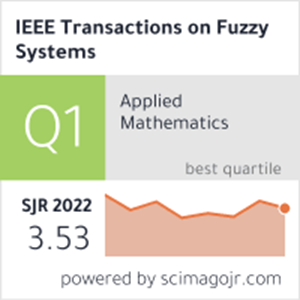Granular-Ball Computing-Based Fuzzy Twin Support Vector Machine for Pattern Classification
IF 11.9
1区 计算机科学
Q1 COMPUTER SCIENCE, ARTIFICIAL INTELLIGENCE
引用次数: 0
Abstract
The twin support vector machine (TWSVM) classifier and its fuzzy variant fuzzy twin support vector machine (FTSVM) have received considerable attention due to their low computational complexity. However, their performance often deteriorates when the input data is affected by noise. To overcome this limitation, this study leverages the robustness of granular-ball computing (GBC) against noise to develop more effective classification models by integrating GBC with TWSVM and FTSVM. First, we introduce the granular-ball TWSVM (GBTWSVM) classifier, which incorporates GBC with the TWSVM framework. By replacing traditional point-wise inputs with granular-ball representations, we derive a pair of nonparallel hyperplanes for the GBTWSVM classifier by solving a quadratic programming problem. Afterwards, we develop the granular-ball FTSVM (GBFTSVM) classifier, where the membership and nonmembership functions of granular-balls are defined using Pythagorean fuzzy sets, enabling a more nuanced differentiation of the contributions of granular-balls from distinct regions within the input space. By incorporating these functions into the FTSVM framework, we derive a pair of nonparallel hyperplanes for the GBFTSVM classifier through the solution of a quadratic programming problem. Finally, we present algorithms for the GBTWSVM and GBFTSVM classifiers and evaluate their performance on 21 benchmark datasets. Experimental results demonstrate the superior scalability, computational efficiency, and robustness of the proposed classifiers in pattern recognition, highlighting their potential as advanced tools for noise-tolerant classification.基于颗粒球计算的模糊双支持向量机模式分类
孪生支持向量机(TWSVM)分类器及其模糊变体模糊孪生支持向量机(FTSVM)因其较低的计算复杂度而受到广泛关注。然而,当输入数据受到噪声的影响时,它们的性能往往会下降。为了克服这一限制,本研究利用颗粒球计算(GBC)对噪声的鲁棒性,通过将GBC与TWSVM和FTSVM相结合,开发出更有效的分类模型。首先,我们引入了结合GBC和TWSVM框架的颗粒球TWSVM分类器(GBTWSVM)。通过用颗粒球表示代替传统的点向输入,我们通过求解一个二次规划问题得到了GBTWSVM分类器的一对非并行超平面。随后,我们开发了颗粒球FTSVM (GBFTSVM)分类器,其中使用毕达哥拉斯模糊集定义颗粒球的隶属度和非隶属度函数,从而能够更细致地区分输入空间中不同区域的颗粒球的贡献。将这些函数合并到FTSVM框架中,通过求解一个二次规划问题,得到了GBFTSVM分类器的一对非并行超平面。最后,我们给出了GBTWSVM和gbtsvm分类器的算法,并在21个基准数据集上评估了它们的性能。实验结果表明,所提出的分类器在模式识别中具有优越的可扩展性、计算效率和鲁棒性,突出了它们作为耐噪分类先进工具的潜力。
本文章由计算机程序翻译,如有差异,请以英文原文为准。
求助全文
约1分钟内获得全文
求助全文
来源期刊

IEEE Transactions on Fuzzy Systems
工程技术-工程:电子与电气
CiteScore
20.50
自引率
13.40%
发文量
517
审稿时长
3.0 months
期刊介绍:
The IEEE Transactions on Fuzzy Systems is a scholarly journal that focuses on the theory, design, and application of fuzzy systems. It aims to publish high-quality technical papers that contribute significant technical knowledge and exploratory developments in the field of fuzzy systems. The journal particularly emphasizes engineering systems and scientific applications. In addition to research articles, the Transactions also includes a letters section featuring current information, comments, and rebuttals related to published papers.
 求助内容:
求助内容: 应助结果提醒方式:
应助结果提醒方式:


